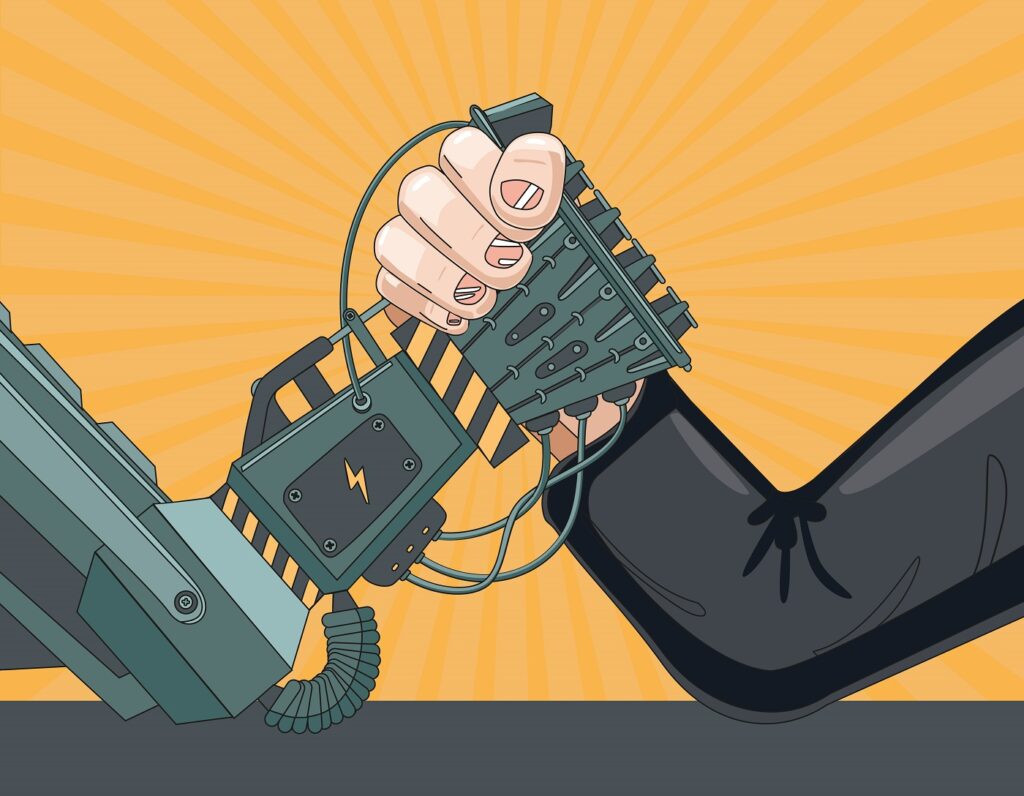Artificial intelligence (AI), machine learning, robotics, self-driving cars – the debate around these innovations is raging. And much of this debate surrounds the power of the ‘machine,’ the fear of job redundancies, the ethics of new technologies and the prospect of unemployment for those who can’t keep up. But is it all that bad? Is this really the end of the “dominant human-species?” Have humans finally met their match?
A lot of the discussion around these topics focuses on how at risk humans are and on how damaging this can be for big business highlighting the disruptive nature of these new technologies.
Less is discussed about how business can actually invest wisely in scalable tech teams and infrastructure and stay ahead of the curve, maintaining a competitive advantage in these rapidly changing times.
Indeed, the purpose of AI is not to outperform man but, rather, to enhance our own capabilities.
The intelligence of computers is actually said to be incredibly narrow in the majority of cases with very few generalist AIs (Google DeepMind being one).
In fact, as it stands, most AI is designed to perform the specific tasks that we assign them; they need vast amounts of data and training to be able to carry out human actions.
This is highly positive for humans, and indeed businesses, as it means that we can utilise AI to compensate for our weaknesses and dramatically improve our effectiveness.
With current processes, companies have had little alternative but to hire based on qualifications
This is why some companies – of which we, at Headstart App, are one – are embracing the increasing capabilities of machine learning, an underlying methodology behind AI, to target one of mankind’s most prevalent shortcomings: unconscious bias.
More specifically, leveraging machine learning to improve diversity and inclusion efforts in the graduate and entry-level recruitment process.
We have seen that some firms have committed to name-blind applications to remove biases and others have even said that degrees will not even be taken into consideration. Often, however, this is still not enough; particularly for organisations with high volumes of applications. If companies truly seek a resource-efficient and highly effective solution for improving diversity and inclusion, they must explore data-driven processes and predictive software to enable this.
Indeed, the purpose of AI is not to outperform man but, rather, to enhance our own capabilities.
Unconscious bias and passive recruitment
Unfortunately, unconscious bias is ingrained in human nature and can’t be avoided.
Every decision we make is undermined by a subjective opinion based on life experience so everything we do results in a degree of, albeit unconscious, bias.
With an increasing number of applicants with good degrees from a select number of universities applying to leading companies year on year, it has become very difficult for recruiters to differentiate between applicants, many of which largely look very similar on paper.
Unfortunately, unconscious bias is ingrained in human nature and can’t be avoided.
The time-constraints of reviewing every application submitted, mean that companies have had to recruit relatively passively over the past few decades, relying largely on “minimum requirements” and “target universities” to reject applicants who recruiters don’t have time to consider.
This is not a choice, per se, but something that has inevitably developed in line with a rise in the number of applicants looking to get on the career ladder via graduate schemes.
This has led to a fairly homogenised workforce within many companies and relatively slow progression towards the improvement of diversity and inclusion.
With current processes, companies have had little alternative but to hire based on qualifications and, in some cases, relevant work experience; there just haven’t been the resources to review every application.
This is magnified by the existence of unconscious bias…
As we’ve discussed, it’s human nature for us to be attracted to those people who remind us of what we know and understand ourselves – those who have experienced similar things and have similar perspectives.
We can’t remove bias from our own brains and to remove all human-led elements of the recruitment process would be foolish.
This unconscious bias means that companies often fall into a vicious circle of hiring the same type of people over and over again; something many find it hard to break.
We can’t remove bias from our own brains and to remove all human-led elements of the recruitment process would be foolish.
But, when we combine unconscious bias with automatic rejections for those candidates who haven’t met minimum requirements, the recruitment process can become very exclusionary by nature.
This exclusionary process, which has been ingrained in student recruitment for years, certainly inhibits diversity and inclusion but is something that technology is now starting to address.
Machine learning
‘Machines’ and data have the power to be objective where we can’t. Whilst we are unable to remove unconscious bias from our own brains, humans, and in this case, recruiters, are able to programme computers to outsmart it.
Computers can be trained to make decisions based on the data they have, much like humans naturally make balanced judgements based on their experiences.
The big difference is that, unlike humans, computers can ‘experience’ a multitude of different ‘lives’ simultaneously through the data it is given and that it processes.
It can make balanced decisions based on a broader and more diverse range of experiences.
A concept which, within recruitment, can lead to fairer and more inclusive hiring decisions.
Ultimately, removing bias will lead to a win-win situation for candidates and employers.
With the help of this new generation of enterprise software, recruiters can begin to build a more inclusive and efficient process that can inform hiring decisions to predict those prospective candidates who are most suited to a given role and, accordingly, those who are most likely to flourish.
As such, it is possible to ensure that the only factor influencing hiring decisions, except at the final stage of the process, is a desire to create and develop the best teams possible.
At this latter stage, recruiters will have all of the information they need to decide upon the most suitable candidates regardless of their university, ethnicity, gender, social background or sexual orientation.
The use of this new software tools means that recruiters will be able to hone in on the most important qualities of prospective employees – their skills, experience, mind-set and cultural fit – rather than their qualifications and ‘polish.’
If companies hire more candidates who excel in these areas, rather than rely on simplistic filters and subjective measures unrelated to performance, they will inevitably see payoffs in greater productivity and output.
Concluding thoughts
If AI has the potential to make fairer hiring and assessment decisions than humans could ever hope to, then why run away from it?
The purpose of AI, as discussed above, is not to outperform people but, rather, to give them an advantage. We shouldn’t get swept up in the hysteria surrounding robots stealing our jobs.
For the most part, the growth of AI will lead to job transformation rather than replacement.
Furthermore, although AI can provide great insight into where best to improve the recruitment process, it is up to recruiters themselves to take this actionable data and use it to design and implement fairer ways of hiring, assessing and developing talent.
Ultimately, removing bias will lead to a win-win situation for candidates and employers.
For the most part, the growth of AI will lead to job transformation rather than replacement.
Not only will a more diverse team allow different perspectives to inspire greater creative thinking, but employees that are best suited to the organisation in terms of their skills and cultural fit are also likely to be the ones who are most motivated to work there and willing to go the extra mile.
As such, applying AI to decision-making can deliver a multitude of tangible business benefits for organisations; not least by supporting them to acquire and develop the top talent they need to grow and compete.
Recruitment processes must advance to exploit this new world. A move away from the ‘old boys network’ to a fairer and more inclusive, technology-driven strategy is key and effective machine learning can enable that change – for the better.






